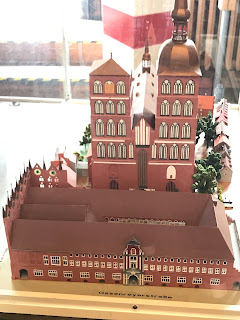Zu Besuch in Stralsund? Knapp mit der Zeit? Man möchte trotzdem alles ansehen? Die Lösung liegt in der Mühlenstraße 3, einem gotischen Dielenhaus aus dem 14.Jahrhundert. Dielenhäuser bestehen aus einer großen Diele, darum heißen sie auch so, die nicht nur fast den ganzen Grundriss einnimmt, sondern mitunter auch zwei Etagen. Dielenhäuser waren oftmals Häuser von Kaufleuten, die dort ihre Ware gelagert und zum Verkauf angeboten haben. Der Achtstundentag war zu dieser Zeit noch unbekannt, oftmals war ein Arbeitstag 12,14 manchmal 16 Stunden lang, da waren große schicke Schlafräume eher unnütz. Das ganze Haus war mehr oder weniger dem Geschäft gewidmet. Hier im Haus kann man auch noch schön den Hausbaum sehen, der das Gewicht der gelagerten Waren auf die Speicheretagen und auf ein Steinfundament leitet. Die große, weite Tür, eher ein Tor machte es möglich, Waren en Gros in das Haus zu verbringen.
Heute gibt es hier keine Waren mehr, sondern Stralsund und die Küste, über 30 Modellbauten zeigen alle bedeutsamen Bauten der Stadt Stralsund, die wir schon beim letzten Stadtrundgang (https://fraumb-far-far-away.blogspot.com/?m=0 ) gesehen haben, sowie einige Leuchttürme von der Ostseeküste. Man kann hier also das Haus und die Stadt gemeinsam erkunden und so viel über die Backsteingotik lernen, sehr praktisch.
English version below
At a visit in Stralsund? Short of time? But want to see as much as possible? The solution is here, at Mühlenstraße 3, a gothic Dielenhaus (hallway house) from the 14th century. Hallway Houses are made of a huge hallway, that’s why the name, it uses nearly all the space of the house and is often two floors high. They have been mostly the houses of merchants, who stored and display their tradeable goods there. The eight-hours-working-day wasn’t invented at this time, working hours often have been 12,14 sometimes 16 hours, less time to sleep and that’s why luxury bedrooms didn’t made sense. The whole house was dedicated to the business. The Hausbaum, a single vertical post, based on the stoney ground in the cellar, that was used for lifting loads of the goods and store it equally it the upper floors to make sure the weight is distributed evenly. The wide door, more a gate, makes it possible to bring big loads into the house.
Today there aren’t any goods anymore, but they have whole Stralsund and some pieces of the coast, as little models, around 30, showing all the important buildings of the city we saw during our stroll through the city the other day (https://fraumb-far-far-away.blogspot.com/?m=0) plus some additional light houses from the Baltic Sea area. You can learn about the house itself and about brick gothic style at the same time, pretty cool.


























Keine Kommentare:
Kommentar veröffentlichen